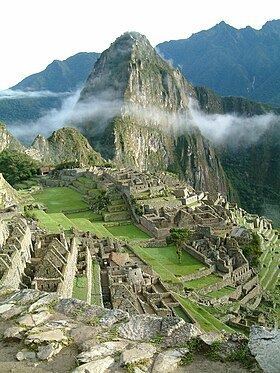Elevation 2,720 m | Prominence 360 m Parent range Andes | |
 | ||
Similar Salcantay, Ausangate, Phutuq K'usi, Huayna Potosí, Kjerag | ||
Huayna Picchu, Wayna Picchu (Hispanicized spellings) or Wayna Pikchu (Quechua wayna young, young man, pikchu pyramid, mountain or prominence with a broad base which ends in sharp peaks, "young peak") is a mountain in Peru around which the Urubamba River bends. It is located in the Cusco Region, Urubamba Province, Machupicchu District. It rises over Machu Picchu, the so-called lost city of the Incas, and divides it into sections. The Incas built a trail up the side of the Huayna Picchu and built temples and terraces on its top. The peak of Huayna Picchu is 2,693 metres (8,835 ft) above sea level, or about 260 metres (850 ft) higher than Machu Picchu.
Contents
Map of Huayna Picchu, Peru
According to local guides, the top of the mountain was the residence for the high priest and the local virgins. Every morning before sunrise, the high priest with a small group would walk to Machu Picchu to signal the coming of the new day. The Temple of the Moon, one of the three major temples in the Machu Picchu area, is nestled on the side of the mountain and is situated at an elevation lower than Machu Picchu. Adjacent to the Temple of the Moon is the Great Cavern, another sacred temple with fine masonry. The other major local temples in Machu Picchu are the Temple of the Condor, Temple of Three Windows, Principal Temple, "Unfinished Temple", and the Temple of the Sun, also called the Torreon.
Tourism
Huayna Picchu may be visited throughout the year, but the number of daily visitors allowed on Huayna Picchu is restricted to 400. A steep and, at times, exposed pathway leads to the summit. Some portions are slippery and steel cables (a via ferrata) provide some support during the one-hour climb. The ascent is more challenging between November and April because the path up the mountain becomes slippery in the rainy season. Better conditions for climbing can be expected during the dry season, which runs from May to September.
From the summit, a second trail leads down to the Gran Caverna and what is known as the Temple of the Moon. These natural caves, on the northern face of the mountain, are lower than the starting point of the trail. The return path from the caves completes a loop around the mountain where it rejoins the main trail.
